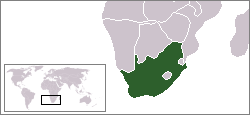West Coast National Park
|
West Coast National Park
|
|
| location | South Africa |
| surface | 363 km² |
| Geographical location | 33 ° 8 ' S , 18 ° 3' E |
| Setup date | 1985 |
| administration | South African National Parks |
The West Coast National Park ( English West Coast National Park ) is located 120 km north of Cape Town in the South African province of Western Cape in the area of the local community Saldanha Bay . The national park is 27,500 hectares and includes the 15 km long Langebaan Lagoon (6,000 hectares), which is open to Saldanha Bay; 30% of the South African salt marshes are located here .
Arrival and overnight
There are two entrances to the park: from the north via the village of Langebaan , from the south an entrance branches off the R 27 into the national park.
There are simple overnight accommodations at the Geelbek Environmental Education Center on the south bank of the lagoon. The information center for environmental and nature protection is also located here. A tea salon offers culinary delicacies here.
Hikes lasting several days are offered, with daily stages of 12 to 15 km in length, overnight stays sometimes on campsites.
From Langebaan you can take a boat trip organized by the park administration over the lagoon to Postberg during the spring flower season, with a guided hike through the blooming landscape in this part of the park.
fauna and Flora
The park is particularly important because of its richness in bird species. It is home to around 750,000 birds in summer, many of them migratory birds from the northern hemisphere. The coast of the West Coast National Park is always supplied with nutrient-rich water by the Benguela Current , which manifests itself in a large number of fish species that feed the large flocks of birds.
The birds are particularly numerous on the islands belonging to the park:
- Jutten Island (43 ha) with 25,000 Cape cormorants
- Malgas Island (18 ha) with 70,000 Cape gannets
- Marcus Island (17 ha); the largest colony of African penguins in the world lives here
- Schaapen Island (29 ha) with Wahlbergscharben (cormorant relatives ) and Dominican gulls
The larger mammals represented are: eland antelope , kudu , hartebeest , great buck , zebra , springbok , oryx and white-tailed wildebeest .
The park is also home to the fynbos , a shrub vegetation found almost exclusively in south-west South Africa, and as part of it also Renosterveld and Strandveld vegetation.
The northwestern part of the park ( Postberg Flower Reserve ) is a major tourist attraction in spring - from August to September - when all the flowers start to bloom. This part of the park will then no longer be accessible to the general public from October. The Postberg region consists of three former farms: Oude Post , Nieuwland and Kreeftebai . The northern end of this park area is a restricted military area and closed to the public all year round.
climate
The climate is temperate, with minimum temperatures rarely below 4 ° C and rarely above 34 ° C. Rain falls mainly in the period from May to September.
history
In 1985, the entire area around the Langebaan lagoon and four offshore islands was declared a national park in order to protect the valuable ecosystem of the lagoon. In 1987, the private Postberg Nature Reserve was incorporated into the park with 1,800 hectares. This part of the national park is still privately owned but is administered by the National Parks Board . The park has been designated as a biosphere reserve by UNESCO since 2000 .
Web links
- South African National Parks: West Coast National Park . National park administration website at www.sanparks.org (English)
- South African National Biodiversity Institute : FSP: Wetlands Saldanha 2007 . at www.bgis.sanbi.org (English)
- Water Institute of Southern Africa: Langebaan Lagoon . on www.ewisa.co.za (English)
- BirdLife South Africa: West Coast National Park and Saldanha Bay Islands . on www.birdlife.org.za (English)
- Travel report in the family & travel blog MrsBerry.de





